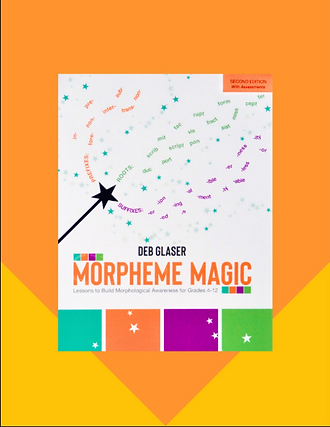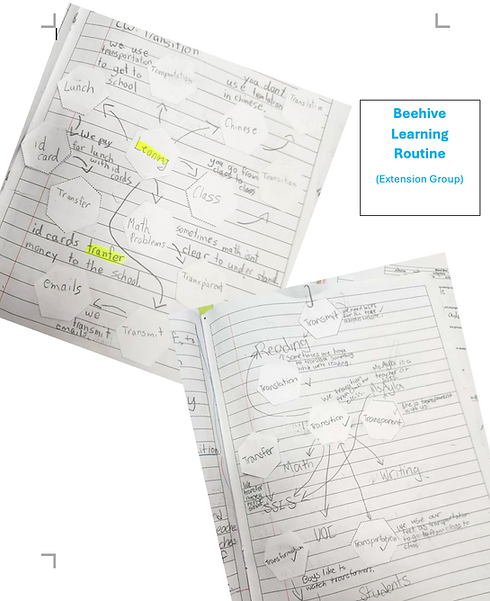Mr. Reed's Room
Morphology Curriculum Redesign
An example of thoughtful planning rooted in differentiation and UDL principles to ensure every learner finds a way to succeed.

The Challenge
Our exsisting morphology curriculum, Morpheme Magic, was highly structured and rigid, often overwhelming students with cognitive overload and vocabulary that felt disconnected from their daily lives and their learning. For many of our non-native English speakers, this created barriers to engagement and limited opportunities to make meaningful connections. My colleague and I recognized the need for a more flexible, relevant, and differentiated approach that ensured all learners could access and apply morphological knowledge in authentic ways.
The Solution
We redesigned our morphology instruction to make it more inclusive, relevant, and accessible for all learners. By using diagnostic grouping, selecting meaningful vocabulary, and creating differentiated routines, we aligned our approach with UDL principles to ensure every student had a clear entry point and path for growth.

Diagnostic Grouping
We assessed students’ morphological awareness and organized them into developing (morphemic), consolidating (semantic), and extending (syntactic) levels. This allowed us to represent the same concept — morphology — in ways that matched each learner’s readiness. For some, this meant seeing morphology in its most concrete form (prefixes, roots, suffixes), while others explored how morphemes shaped meaning, and the most advanced applied morphology in authentic contexts like reading and writing. By doing this, we provided multiple means of representation, ensuring every student could access the big ideas through a lens appropriate to their stage of learning.
Relevant Vocabulary
Instead of teaching isolated or arbitrary word lists, we selected vocabulary tied to our Units of Inquiry and students’ lived experiences. Words like migrate, conflict, or capable connected directly to what students were studying and talking about in other subjects. This made morphology more meaningful and engaging, giving learners a purpose for applying it beyond word study. By embedding vocabulary in authentic contexts, we created multiple means of engagement, allowing students to connect personally with the material and stay motivated to use it.


Differentiated Routines
Each group worked with routines tailored to their level of understanding — breaking down morphemes, exploring semantic relationships, or analyzing syntax in context. These routines also gave students different ways to show what they knew: through word sorts, oral explanations, written reflections, or application in inquiry projects. By designing tasks with flexible output, we offered multiple means of action and expression, giving every student opportunities to demonstrate growth using methods that played to their strengths.
In the section below, you’ll find examples of how my coworker and I planned for student success using the UDL principles of Representation, Expression, and Engagement.

Explore one of our planning documents, which outlines how we considered multiple pathways for different learners to access and understand each newly taught morpheme.

Explore our 2025–2026 vocabulary word lists, designed to engage learners by connecting new language to their reading, writing, math, and unit of inquiry work—as well as to meaningful aspects of their personal lives.

Explore examples of our differentiated, bi‑weekly learning engagements, designed to give students multiple ways to express their understanding and apply their learning.
Examples of Student Work
Here you’ll see snapshots of student work from some of our regular learning routines. These examples highlight the many ways learners apply new skills, express their understanding, and connect their learning across subjects. It’s a chance to celebrate their voices and the many paths they take in learning.

Picture Riddles
Picture Riddles was especially meaningful for our Developing Group working at the morphemic stage. Early on, students relied on drawing and word parts to make sense of vocabulary, but as the year progressed they began connecting these parts to broader meanings. This shift from morphemic awareness into semantic understanding was visible in the way their sentences became more accurate, descriptive, and connected to context.
Word Chains
Word Chains was a designed for our Consolidating (semantic) Group. These students were ready to engage with vocabulary by making meaning‑based connections, moving beyond word parts into how words relate to one another. In this routine, they linked a focus word to related words, explained each connection in a complete sentence, and worked to finish their chain with another focus word, this strengthened their semantic networks and deepening overall word knowledge.


Beehive Connections
In the Beehive Connections activity, students chose focus words, arranged them in hexagons, and connected them with arrows. For each connection, they wrote a short sentence explaining the relationship between words. This routine supported our Extension Group, whose learning was primarily syntactic, by encouraging them to make increasingly complex, sentence‑level connections that showed how words interact within broader structures and ideas.